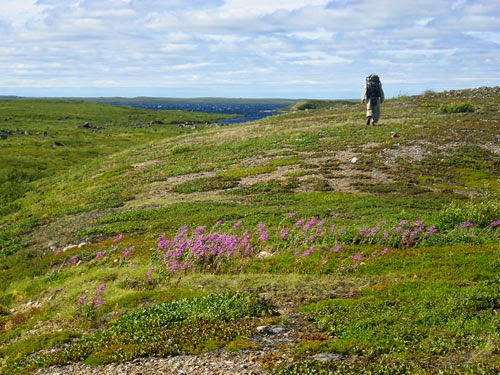Distance: 24 km paddling, plus 15 km walking
Location: Latitude:63.57511, Longitude:-105.72670 at 07/19/2014 08:09:11 PDT
Map link: Click here
Today we did really well to make progress in conditions that should normally have restricted us to land. The wind was fierce, around 30 knots out of the west. This was a tailwind, but it was so strong that it would be unsafe to be on open water in a canoe. However, we managed to figure out a circuitous route, made up of narrow channels, lake shores along which we could handrail and shelter from the wind, and very short crossings in which the wind was directly behind us and in which we could literally surf on breaking but manageable following seas. In this way, we were able to paddle to the first portage of our trip, here and complete it in cool, windy, bug-free conditions.
The portage was under 1 km in length, and enabled us to negotiate an unrunnable, but very scenic waterfall. There was no trail, but the conditions under foot were reasonably friendly and there was relatively little elevation gain or loss involved. All of our training and preparation for portaging paid off, and the portage went smoothly. It was, however, too windy to carry the canoe in the normal way. The windage of the canoe was such that in these gale force winds you would quite litterally be blown over if the canoe turned sideways to the wind. Trailing a line from the stern (it was a tail wind), so a second person could keep the end of the canoe pointing into the wind like a weather vein, allowed us to get the canoe to the other end, but we need more practice at this.
With the first portage complete, were were then able to continue our careful strategy of using terrain to keep out of the wind where possible, and surfing when we were crossing with the wind behind us, in order to reach Grove Rapids, the second portage of our journey. This second portage is about 2 km long with much more elevation change (gain and loss). It starts out following the top of an esker, which makes conditions underfoot very nice and smooth. The esker does not, however, follow the river. So it is an interesting overland journey through scenic terrain of small lakes and craggy hills. Eventually you climb to a ridge from which you have an extensive view down to Hanbury Lake. The descent goes across rocking ridges, small crags and through some boggy areas before arriving at a very steep lake shore with small cliffs. We found a sheltered place to camp with beautiful views over the lake, and left the task of lowering the canoe and gear to the water until the morning.
Portaging the bags was a fairly straightforward, albeit tiring, process. In practice, 2 km feels much longer than it sounds in theory. This is especially true when you are lugging a 70 lb bag on your back, but we had trained well enough to be able to do each pass without stopping to rest. Portaging the canoe was challenging though. The gale force winds on the esker were so fierce that they made shouldering the canoe impossible. This was partly due to the strength of the wind and partly due to the direction (a cross wind in places). So we were forced to do a two person carry using the handles at each end of the canoe. The portage was broken into many short sprints, before putting the canoe down, changing hands, and sprinting again. From the top of the ridge I then dragged the canoe downhill over the tundra and boggy areas. This was actually easier than carrying it. All in all, this portage took us about 4 hours and involved 10 km of walking (three journeys with load and two returns).
We were very happy to have been able to make such progress on such a fierce windy day, while minimizing our exposure to danger. Due to our wind evading strategies, we probably paddled at least 5km further than necessary, but that is what made the journey possible on a day like this.
The area around Hanbury lake is beautiful, as is Grove rapids, and the esker we portage along. There are a few groves of very small spruce trees which is quite unexpected after the last few days of spartan tundra scenary. We are now laying in the tent on a thick bed of soft, spongey, moss, maybe a foot or two thick. It is like sleeping on a giant water bed, and is oh so comfortable after two strenuous portages and 24km of paddling in gale force winds.








